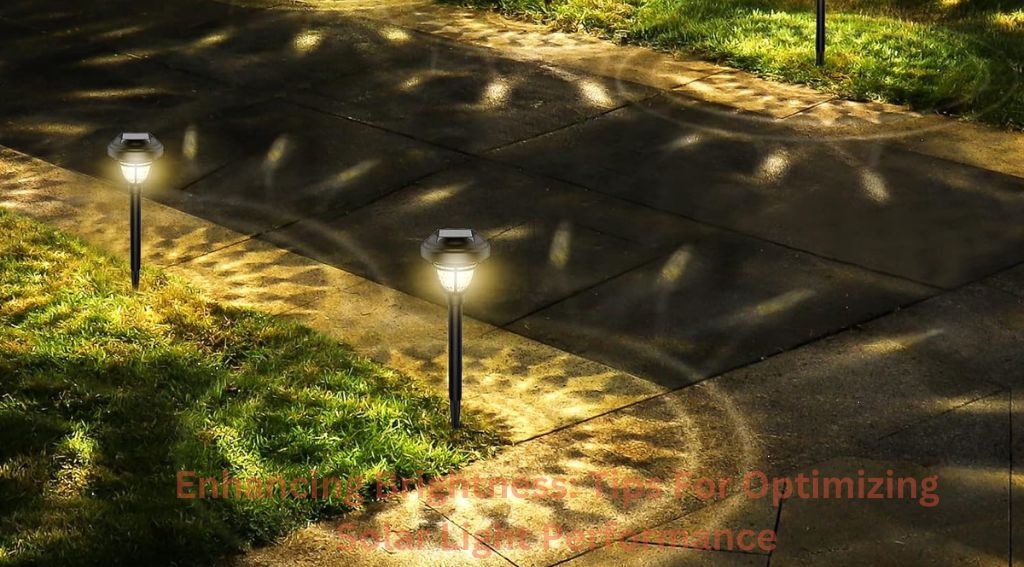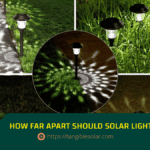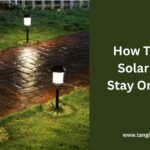How bright is 10 lumens solar light? Unveiling its Illuminating Power
A bright 10 lumens solar light is moderately bright and produces a gentle glow for outdoor spaces. With a brightness level of 10 lumens, it is suitable for decorative purposes, creating a subtle ambiance, or providing a low level of lighting for pathways or garden areas.
Understanding Lumens: Measuring Brightness
The bright, illuminating glow of a 10-lumen solar light can be a game-changer when it comes to outdoor lighting. But what exactly do lumens mean? And how can you compare them to other units of measurement? In this article, we will explore the concept of lumens and their significance in determining light intensity, enabling you to make an informed decision when it comes to choosing the right solar light for your needs.
What Are Lumens, and How Are They Measured?
When it comes to measuring brightness, lumens are the go-to unit of measurement. Lumens represent the total amount of visible light emitted by a source, such as a solar. In simple terms, the higher the number of lumens, the brighter the light will appear. So, what exactly does 10 lumens of solar light mean?
How do solar lights work at night?
Well, a 10-lumen solar light provides a subtle, soft glow that is perfect for creating a cozy ambiance in your outdoor space. It may not be as bright as other options on the market, but its low-intensity light is perfect for adding a touch of magic to your garden, patio, or pathway.
Comparing Lumens to Other Units of Measurement.
While lumens are a widely used unit of measurement for brightness, it’s helpful to understand how they compare to other units. One common unit you may come across is watts. Unlike lumens, which measure the amount of light emitted, watts measure the amount of energy the light source consumes.
For example, a 10-watt incandescent bulb may produce around 100 lumens of light. In contrast, a 10-lumen solar light may consume only a fraction of that energy, making it much more energy-efficient and eco-friendly.
The Significance of Lumens in Determining Light Intensity.
The quantity of lumens is a key factor in determining how intensely a source emits light. Whether you’re lighting up a pathway or creating a warm atmosphere on a summer evening, understanding the significance of lumens can help you choose the right solar light for your specific needs.
Not only does the number of lumens impact the brightness, but it also determines the coverage area of the light. Higher lumen outputs will illuminate a larger area, while lower outputs, like the bright, 10-lumen solar light, are ideal for smaller, more intimate spaces.
In conclusion, lumens are a valuable unit of measurement when it comes to choosing the right solar light. Whether you opt for a 10-lumen solar light or a higher-output option, understanding lumens and their significance in determining light intensity will enable you to create the perfect outdoor ambiance.
An In-Depth Look at the Brightness Level of 10 Lumens.
When it comes to choosing solar lights for your outdoor spaces, understanding the brightness level is crucial. One common measurement used to determine brightness is lumens. A 10-lumen solar light is considered to have a low to moderate brightness level. But what does that mean? Let’s decode 10 lumens and explore how bright it is.
Comparing 10 Lumens to Other Common Light Sources.

To put 10 lumens into perspective, it helps to compare it to other familiar light sources. While it may not seem very bright compared to traditional household lights, solar lights serve a different purpose. To give you an idea:
| Light Source | Brightness Level |
| 10 Lumens Solar Light | Low to moderate |
| Candle | 2-6 lumens |
| Incandescent Lightbulb (40W) | 450-800 lumens |
| LED Lightbulb (60W equivalent) | 800-1100 lumens |
| Car Headlights (low beam) | 700-1000 lumens |
As you can see, a bright 10-lumen solar light falls within the range of a candle, providing a gentle ambiance rather than a strong, direct light source.
Understanding the Practical Applications of 10 Lumens Solar Lights.
While 10 lumens may not be the brightest option available, these solar lights can be incredibly useful in various outdoor settings. Here are some practical applications:
- Highlighting walkways and pathways will guide your steps in the dark.
- Creating a cozy atmosphere on a patio or deck during evening gatherings.
- Adding a touch of charm to a garden or landscaping feature.
- Providing subtle lighting will enhance the safety and security of your outdoor spaces.
When it comes to solar lighting, it’s important to remember that the brightness level is just one factor to consider. Other factors, such as color temperature and beam angle, also contribute to the overall lighting effect. So, while a 10-lumen solar light may not be the brightest, it can still serve a valuable purpose in enhancing the ambiance and functionality of your outdoor areas.
Factors Affecting Brightness: Unveiling The Variables
Nowadays, solar lights have become popular not only for their energy-efficient and eco-friendly nature but also for their versatility and ease of use. However, when it comes to the brightness of these lights, certain factors can affect their overall illumination. Identifying and understanding these variables is crucial to ensuring that you get the most out of your solar light investment. In this article, we will dive into the key factors of weather conditions and battery capacity and explore how they impact the brightness of a 10-lumen solar light.
Identifying The Factors That Can Affect The Brightness Of Solar Lights
Before delving into how weather conditions and battery capacity affect the brightness of solar lights, it is essential to identify the different factors that can contribute to changes in illumination. These factors include:
- Light intensity: The amount of natural or artificial light present in the surroundings
- Light angle: The angle at which the solar panel is positioned to capture sunlight
- Placement: The location where the solar light is installed, such as whether it is in direct sunlight or shaded areas
- Solar panel efficiency: The effectiveness of the solar panel in converting sunlight into electrical energy
Explanation Of How Weather Conditions Can Impact The Illumination
Weather conditions play an essential role in determining the brightness of a bright 10-lumens solar light. Various weather elements can either enhance or hinder the performance of solar lights. Here’s a breakdown of how different weather conditions can impact illumination:
| Weather Condition | Impact on Illumination |
| Sunny | The abundance of sunlight ensures maximum solar panel exposure, resulting in optimal brightness. |
| Cloudy | While solar lights can still produce illumination on cloudy days, the brightness may be reduced due to the lower intensity of sunlight. |
| Rainy | During rainy weather, the solar panel may receive limited sunlight, leading to a temporary decrease in brightness. |
| Winter | In colder climates, solar lights may experience decreased performance due to shorter daylight hours and lower light intensity. |
Understanding The Role Of Battery Capacity In Maintaining Brightness
Another crucial factor that affects the brightness of solar lights is the battery capacity. When there isn’t any sunlight, the battery releases the energy that the solar panel has stored during the day to power the light source. Here’s how the battery capacity impacts brightness:
- Adequate battery capacity: With a higher-capacity battery, solar lights can provide consistent illumination for longer durations, ensuring a brighter output throughout the night.
- Insufficient battery capacity: On the other hand, a limited battery capacity may result in reduced brightness or even premature light shut-off during the night.
In conclusion, several variables can influence the brightness of a 10-lumen solar light. Weather conditions, such as sunlight intensity and cloud cover, can impact illumination, while battery capacity plays a crucial role in maintaining brightness throughout the night. By understanding these factors and making informed choices, you can optimize the performance of your solar lights and enjoy well-illuminated spaces, even in the darkest of nights.
Enhancing Brightness: Tips For Optimizing Solar Light Performance

Practical Strategies For Maximizing The Brightness of 10 Lumens Solar Light
When it comes to solar lights, even a small increase in brightness can make a big difference in illuminating your outdoor spaces. If you have a 10-lumen solar light and want to enhance its brightness to illuminate your garden, pathway, or patio, there are a few practical strategies you can employ.
- Choose the right location. Position your solar light in an area where it can receive direct sunlight for the majority of the day. This ensures that the solar panel can absorb maximum sunlight, charging the batteries to their full capacity and enhancing the brightness of the light during the night.
- Clean the solar panels regularly. Over time, dirt, dust, and debris can accumulate on the solar panels, reducing their ability to absorb sunlight. Keep the panels clean by gently wiping away any dirt or grime with a soft cloth. Regular cleaning not only optimizes brightness but also increases the overall efficiency of your solar light.
- Replace old batteries. The batteries in your solar light are responsible for storing the energy collected from the sun. If the batteries become weak or degraded, it can significantly impact the brightness of the light. Make sure to replace old or worn-out batteries with new ones to maintain the desired level of brightness.
- Consider multiple light sources: If you have multiple solar lights in your outdoor area, strategically placing them can enhance the overall brightness. Instead of relying on a single 10-lumen light, distribute several lights across your space to provide a more consistent and brighter illumination.
Placement And Positioning Tips For Optimal Sunlight Exposure
When it comes to solar lights, proper placement and positioning play a crucial role in optimizing their performance. Here are some tips to ensure your solar light receives optimal sunlight exposure:
- Select an open space. This allows maximum sunlight to reach the solar panel, ensuring efficient charging.
- Avoid shaded areas: Shaded areas receive less sunlight, which can negatively affect the brightness of your solar light. Ensure that your light is positioned away from any shadows, especially during peak sunlight hours.
- Angle the solar panel: Adjust the angle of the solar panel to optimize sunlight absorption. Most solar lights have an adjustable panel that can be tilted to face the sun directly, improving charging efficiency and maximizing brightness.
- Regularly check for obstructions. Keep an eye on your outdoor surroundings and remove any potential obstructions that may impede the sunlight from reaching the solar panel. This may include overgrown vegetation or objects that cast shadows.
Maintenance And Care Practices To Ensure Long-lasting Brightness
To maintain long-lasting brightness in your bright 10 lumens solar light, it’s essential to follow these maintenance and care practices:
- Clean the light regularly. Dust, dirt, and debris can accumulate on the light fixtures, diminishing the brightness they emit. Regularly clean the surfaces with a damp cloth to remove any buildup and keep the light shining at its best.
- Inspect and tighten connections: Periodically check the connections between the solar panel, battery, and light to ensure they are secure. Loose connections can cause a drop in output and brightness.
- Protect against extreme weather conditions: Solar lights are designed to withstand outdoor conditions, but extreme weather can still have an impact. During harsh weather, such as heavy rainstorms or snowfall, it’s advisable to temporarily remove the solar lights and store them indoors to prevent any damage that could affect their brightness.
- Replace faulty components: If you notice any signs of malfunction, such as dimming or flickering lights, it’s important to troubleshoot and identify the issue promptly. Faulty components, such as a damaged solar panel or worn-out LED bulbs, should be replaced to maintain optimal brightness and performance.
Frequently Asked Questions Of How Bright 10 Lumens Solar Light
How Light Is 10 Lumens?
10 lumens is a measure of light intensity. It is relatively low, equivalent to a small flashlight or a nightlight.
How Many Lumens Are Good for Solar Lights?
Solar lights with a range of 100 to 200 lumens are considered good for most outdoor lighting needs. Higher lumens may be required for brighter illumination or larger areas. Remember to choose lights that suit your specific requirements and location.
Which is brighter, 8 or 10 lumens?
10 lumens is brighter than 8 lumens.
What Does 10 Lumen Mean?
10 lumens refers to the brightness measurement of a light source. Specifically, it signifies the amount of light produced within a given area. Lumens are a measurement unit for the amount of visible light an object emits.
Conclusion
The bright 10-lumens solar light is a versatile and energy-efficient lighting solution that can brighten up any outdoor space. With its compact design, easy installation, and long-lasting performance, it is an excellent choice for illuminating pathways, gardens, and patio areas.
Whether you are looking to enhance the ambiance of your outdoor space or provide functional lighting, the bright 10-lumen solar light is a reliable and eco-friendly option. Invest in this efficient lighting solution and enjoy the benefits of bright, sustainable illumination.




